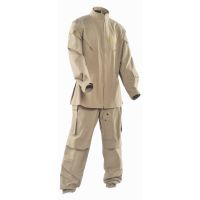The flight suit is the latest development of the flight jacket. The really high-tech flight suits use special materials and are designed to give the wearer maximum comfort and protection. The ultimate development (currently anyway,) is the space suit which provides the wearer with built-in life support equipment and protection that the earth’s atmosphere provides naturally for everybody else. But how did the flight suit develop from the flight jacket?

Army Universe Flight Suits |

Rothco Men’s Flight Suit |

Kid’s Air Force Flight Suit |

Dickies Women’s Flight Suit |

Leg Avenue Men’s Flight Suit |
Originally the jackets used by horse riders were fairly basic affairs – something to keep out the cold and to provide a relatively hard-wearing outer garment which would be more resistant to the weather and ground conditions, especially during winter.
Of course, some parts of the world required thicker jackets than others due to their naturally colder or harsher weather, but these jackets were still relatively simple garments.
With the introduction of the horse-less carriage, the increased speed of the vehicles (after getting rid of the man who had to walk in front holding a red flag to warn other road users) meant that warmer jackets were required which led to further development.
From there it was a short leap into aircraft use – what worked in the automobile would surely work in the aircraft. So it proved to be. However, in this case, further development of the leather jacket took it into what became known as the flying jacket or flight jacket.
Aircraft development resulted in faster aircraft which became more sleekly designed. The cockpits were by now completely enclosed and the emphasis became not so much one of warmth and protection from the elements, but rather more one of comfort and ensuring that loose clothing did not impede any of the flight controls or instruments in the now rather confined cockpits.
 Drifire NAVAIR Flight Suit |
|
Coupled with the development of the flight suit came the “g-suit”. This is basically a suit with air tubes built into it, especially in the leg and stomach areas. It had been known for a while that the high gravitational forces caused by some aircraft maneuvers could cause a pilot to lose consciousness – to black out. This was found to be caused by a lack of blood to the brain caused by those high-g forces which drained the blood down into the lower parts of the body. Designing a system that detected these forces and inflated the tubes at the appropriate times to literally squeeze the body, prevented or at least reduced that blood drain and reduced the instances of pilot black-out. Of course it also meant that pilots could now tolerate higher g-forces than previously!
Even though there are highly technical (and expensive) flight suits available, a basic one-piece suit made of cotton or some other non-inflammable material will meet the requirements of most recreational pilots.
They have the advantage of being fitted with numerous pockets which are handy for storing (and misplacing) small items and do not interfere with the job of flying the aircraft.
For use in areas where they are likely to get dirty, a tougher material is recommended, although those extra pockets can still be useful.
There are fairly cheap suits available that can be used as an overall to protect the wearer’s other clothing. These suits are cheap enough to be regarded as virtually disposable. Wear them a few times and then replace them.
Decide in advance what you are going to use the flight suit for then decide which one will best suit your needs.
